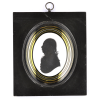Lovell, Thomas
Introduction:
Thomas Lovell became a silhouette artist late in life, after a career as a glass and pottery salesman. He worked for a time at John Miers’ studio on the Strand, before establishing himself independently. One trade label known advertises his skills in jewellery work, though no examples have been discovered.
An exact date of birth for Lovell cannot be established, though from the age of his child it can be assumed he was born around 1760. Presumably he was therefore in his forties when he began silhouette work, after a time as a glass and pottery salesman. He worked in John Miers’ studio from 1799 to 1801, before establishing his own premises at 32 Bread Street, Cheapside, London. His trade label mentions the provision of jewellery work, particularly mourning rings. It is possible he learnt this while working for Miers, though as no examples of his work have been found it is impossible to know. The majority of known work is housed in papier-mâché frames with pearwood ovals, finished with convex glass, either plain or verre eglomise.
Lovell’s work is generally considered to be of average quality. McKechnie describes some examples thus: “Most of the few known examples were not executed with particular skill. Some can hardly have flattered their sitters; possibly Lovell took up his art too late in life to acquire easily the skill of rendering a pleasing likeness in profile.” Today this might be considered quite a harsh assessment. While Lovell’s execution of shirt-frills and hair was less accomplished than his more illustrious contemporaries, he showed attention to detail in the doming of buttons on men’s frocks, where most painters on plaster showed buttons as flat or concave.
Additional research about Thomas Lovell:
Source: McKechnie (Author of, British Silhouette Artists and their Work 1760-1860)
Lovell, Thomas (McKechnie Section 4)Lovell, Thomas (McKechnie Section 5)

